Being an interpreter can mean a number of things. ‘Interpretation‘ is an umbrella term for a number of slightly different activities. In other words, there are several types of interpreting.
You may have heard of simultaneous interpretation or consecutive interpretation. These are the most widely-known modes.
But did you know there are also several other types and sub-types? Have you ever heard of whispering? Or liaison interpreting? Or SimConsec?
In this post I will cover some of the main types of interpreting, explain what makes them so different and what are the typical scenarios in which each type is used.
I also hope this will help clarifying some of the existing confusion about this topic.
Note: To learn more about what interpreters do and how to become one, make sure to check my other post on the subject:
Continue Reading: How to Become an Interpreter
What’s an Interpreter?
Before we jump to the main topic of this post, let’s just quickly recap what interpreters actually do.
To simplify the answer, we can broadly define an interpreter as a linguist whose job is to translate (or, more accurately, ‘render‘) oral text from one language to another.
Translators, on the other hand, work with written text only.
For further details on how interpretation differs from translation, I’ve already dedicated an entire post to it:
Continue Reading: The Difference Between Translation and Interpretation
Simultaneous vs Consecutive Interpretation
There are two major interpreting modes: simultaneous and consecutive interpreting.
Broadly speaking, virtually all other types of interpretation end up being a variation of consecutive or simultaneous one way or another.
Simultaneous | Consecutive | |
"Translating while listening" | "Listening, then translating" | |
Definition | The interpreter delivers the translation while the speaker is producing the source speech. | The interpreter delivers the translation after the speaker has completed the source speech (or a section of it.) |
Equipment | Depending on the exact setting, the following may be used:
| Depending on the exact setting, the following may be used:
|
Typical Settings | Conferences, board meetings, certain tour guides, etc. | Business meetings, press conferences, public service (court, hospitals, etc.), etc. |
But first, let’s cover simultaneous and consecutive in more detail before introducing their respective sub-types.
Simultaneous Interpreting
Simultaneous interpreting (SI) is characterised by its extremely high level of immediacy: the interpreter is required to render the speech into the target language while the speaker is presenting the original text (i.e., virtually at the same time).
This is the type of interpretation that you may be familiar with from high profile conferences and large meetings. Examples include those carried out by the United Nations, the European Parliament, and so forth.
It’s also widely used in smaller conferences, board meetings of large multinationals, international court hearings, etc.
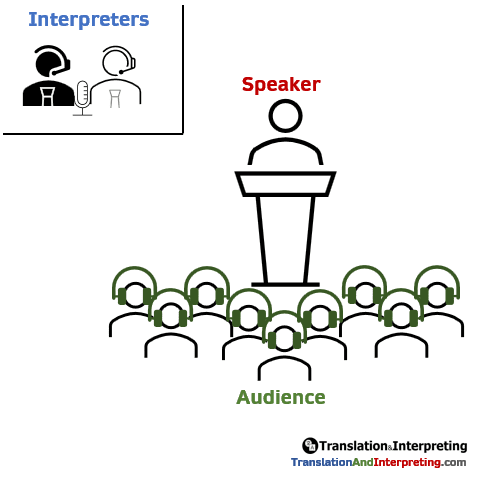
In the vast majority of cases, under optimal circumstances, it’s characterised by the following elements:
- It’s carried out by a team of two interpreters per language combination working as a pair.
- They switch roles every 20 to 30 minutes. While one interprets, the other takes a supporting role through organising information, taking notes, looking up words, and so forth.
- The interpreters work inside a soundproof booth fully equipped with a 2-channel audio transmission system. It normally works like this:
- The interpreter listens to the original speech through headphones while this is being presented.
- While listening to the original speech, the interpreter translates it into the target language, at the same time, through a transmitter.
- The target audience listens to the translated version of the speech through a wireless headphone set equipped with a receiver.
This mode may also be used on certain types of tour guides, in which scenario the operating equipment will consist of a wireless tour guide system.
Main Challenges
Simultaneous interpretation is known for its high levels of cognitive effort. Interpreters need to deal with challenges such as:
- Time Pressure: Simultaneous interpreting is the most time-sensitive type of interpretation. The ‘gap’ between what the speakers says and the translation into the target language (better known as décalage) must be kept short, typically around 2 seconds – that’s the only way the interpreter can render the text without losing track of what’s being said. This is also where the term ‘simultaneous’ comes from: the translation is pretty much immediate.
- Speed of Delivery: Different speakers will speak differently. Some speak slowly and clearly, while others talk as if they were sprinting. Interpreters have to deal with that all the time.
- Terminology: Being such an immediate activity, looking for technical terminology on a dictionary or online is out of question. There are several techniques professional interpreters apply to handle challenging terminology, but nothing beats preparation. The speech may sometimes be given to the interpreter in advance, but that’s not always the case.
- Accents: Interpreters also need to deal with different accents, which sometimes proves to be a challenge.
- Untranslatable Terms and Expressions: Some things are difficult enough to translate even when you have the time to think and do some research, let alone if you’ve only got a couple of seconds to do it. Some of the most infamous ‘interpretation nightmares’ include proverbs, puns and jokes.
- Lack of Clarification: Unlike consecutive (as we’ll see), simultaneous interpretation does not allow interpreters to ask for a clarification if they haven’t understood something.
Simultaneous interpreters learn how to handle all these challenges with lots of practice and experience. It’s an activity the human brain is not designed to do, hence why training is so important to achieve success.
Is ‘Simultaneous Interpreting’ the Same as ‘Conference Interpreting’?
No, not quite.
Because simultaneous interpretation became the predominant mode in modern conferences, both terms are often used interchangeably. That’s not accurate, though!
It’s true that most conferences these days tick all the above boxes, but there are plenty of events outside the conference sphere in which the simultaneous mode is also used.
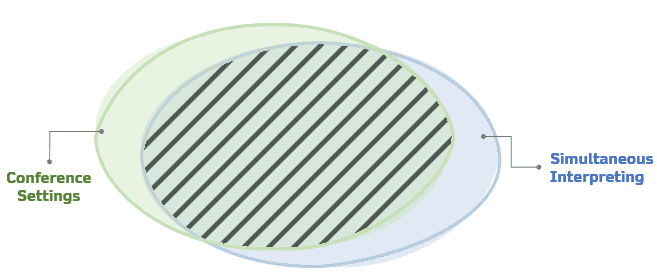
Equally, even though that’s increasingly rare, a conference may also be mediated by a consecutive interpreter.
That normally happens due to budgetary reasons. SI tends to be far more costly, for it requires two interpreters instead of just one, and there’s a lot of expensive equipment to be rented, installed and operated throughout the event.
So, to conclude, although nowadays most conferences involve SI, ‘simultaneous interpreting‘ and ‘conference interpreting‘ are not necessarily one and the same thing.
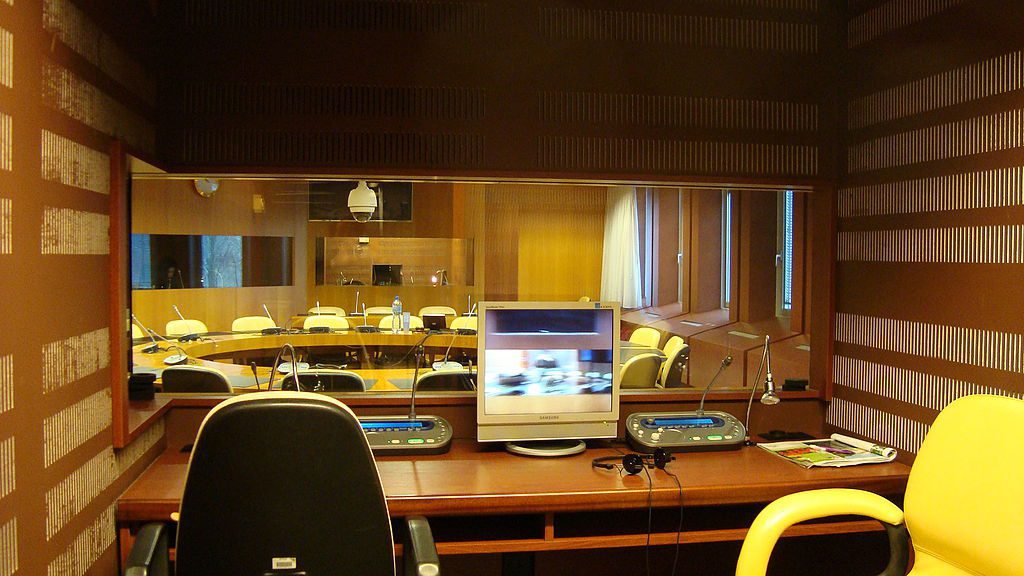
Sub-Types of Simultaneous Interpreting
The most common sub-types of simultaneous interpreting (i.e., modes that end up being a type of SI one way or another) include:
- Whispering
- Respeaking
We’ll cover these modes in more detail further down in this post.
Note that this list is not exhaustive. In addition, it’s important to keep in mind that the advent of technology has been creating new forms and methods of managing interpreter-mediated events.
Consecutive Interpreting
In consecutive interpreting (CI) the linguist renders the original speech (or part of thereof) into the target language after the speaker has completed it.
Typically – especially in formal settings – the sections (or ‘chunks of speech‘) to interpret may last from 5 to 10 minutes, though in some cases it may be even longer.
The main element that makes it very demanding is the fact it normally involves note-taking.
This mode is widely used in settings such as press conferences, business meetings and summits.
It may also be used in certain types of conference where budgetary issues make it impossible to mediate the event via simultaneous interpreting.
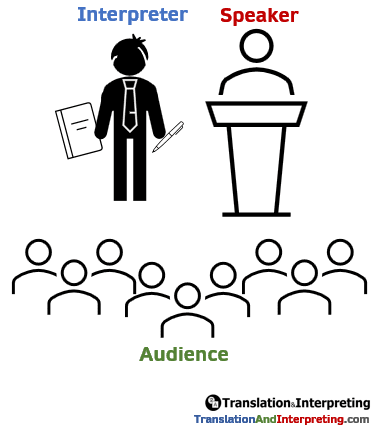
In the vast majority of cases, under optimal circumstances, it is characterised by the following elements:
- Each language combination is normally served by one single interpreter.
- The speaker presents his or her speech, or part of thereof, for around 5 to 10 minutes. While this happens, the interpreter is on the sideline taking notes.
- When the speaker is done, the interpreter renders what has been said (that’s where the term consecutive comes from on). This is largely done with the help from the notes and complemented by a proficient process of active listening and memory retention.
Consecutive used to be the dominant type of interpretation even for conferences and large events. Simultaneous only became the standard in those settings around the mid-20th century, once new technological advances made it possible.
Main Challenges
Some of the challenges that apply to SI also apply to CI. Speed of delivery, terminology, accents and untranslatable terms and expressions are shared by both modes.
The main differences between the two in terms of challenges are:
- Time Pressure: Consecutive is less time-sensitive than simultaneous in the sense the interpreter is not talking at the same time as the speaker.
- Exposure: CI in far more challenging than SI in terms of exposure. In simultaneous, the interpreters are normally inside a soundproof booth somewhere in the building, or even in a completely separate location miles away from the venue – they’re out of sight, the crowd can’t see them. In consecutive, the interpreter shows his face and renders the speech right in front of the attendance.
- Room for Clarification: If the interpreter hasn’t understood something he or she senses it’s vital information, it may be okay to quickly ask for a clarification. This, of course, must only be used to a limited degree and depending on the exact setting (for instances, doing this in a high profile summit between two political leaders is probably not advisable.)
- Note-Taking: This is the most vital aspect of CI and the most challenging too. It’s absolutely impossible to write at the same speed people talk, so developing a highly efficient note-taking system is a must. Doing that correctly requires a thorough training programme and lots of experience and practice.
As you can see, even though both interpreting modes share many elements, the main underlying hard skills are quite distinct.
Nowadays, university programs are likely to offer training in both, but many interpreters may end up specialising in one type over the other.
Sub-Types of Consecutive Interpreting
The most common sub-type of consecutive interpreting is Liaison Interpreting (also known as Dialogue Interpreting.)
Again, this will be covered further down in this post.
Which one is harder?
This is one of the ‘hottest’ topic in the interpreting community, and, like so many others, it’s completely open to debate.
Some swear simultaneous is a thousand times harder than consecutive, while others claim the exact opposite.
SI is extremely demanding due to the fact it consists of such an unnatural activity. CI is also extremely demanding due to the note-taking aspect and to the much higher level of exposure.

I will not give you my input as an interpreter on this topic, but it will be interesting to share with you what my experience as a project manager has showed me.
When I first entered the translation industry as a PM back in 2017, my initial role was almost 100% dedicated to interpreting events.
One of the things I soon realised was that booking interpreters for high profile simultaneous assignments almost always felt easier than it was for an equivalent consecutive one.
Of course, this may not tell us much about the actual level of difficulty. There may have been other underlying factors for this trend.
Nevertheless, that gave me the sense that the same group of professional interpreters would usually find simultaneous assignments desirable, but run away when asked to do consecutive.
Could this suggest that note-taking is more frightening than listening and talking at the same time? 🙂
Which one is the hardest, simultaneous or consecutive interpretation? Let me know your opinion in the comment section, I’d really love to hear your opinion!
Interpreting Sub-Types
These were already briefly touch upon, so here’s a more elucidative description:
Whispering (Chuchotage)
A type of SI that does not involve any equipment. It’s ideal for events where there’s only a couple of people in the entire room who do not understand the language of delivery.
Under normal circumstances the interpreter sits slightly behind the person who needs the translation, and interprets the original speech directly to the person’s ear.
Mikhail Gorbachev and Ronald Reagan communicate through their interpreters, during their first official meeting, Geneva, Switzerland, November 21, 1985 – [1400×917] from r/HistoryPorn
All that happens while the speech is being presented, thus being a form of simultaneous interpretation.
Despite being known as ‘whispering‘, the term is not to be taken literally.
Interpreters have to translate what’s being said in a low tone of voice in order not to disrupt the event. But they don’t exactly whisper either, for they need to ensure the person they’re assisting actually hears what they say.
Typically, one interpreter can assist up to two people at the same time. More than that and it becomes extremely difficult to maintain the low tone of voice.
Respeaking (Speech-to-Text Interpreting)
Respeaking is a fascinating mode. It’s essentially a speech-to-text type of interpreting, which also makes it largely inter-semiotic.
If you live in or have been to the UK, you may have noticed how the TV in many pubs always displays subtitles. That’s respeaking making its ‘magic’.
For that to happen, an interpreter is responsible for shadowing what’s being said in the TV channel (i.e., repeat the exact same words, virtually at the same time) to a computer or laptop equipped with a speech-to-text software. A widely-used software in TV media for that purpose is Nuance’s Dragon Naturally Speaking.
Essentially, this small ‘secret’ it what makes the subtitles pop-up at the bottom of the TV screen.
Respeaking is less complex than standard SI in the sense it doesn’t involve translation. As mentioned, the interpreter shadows the original speech in the same language (it’s a monolingual mode.)
However, in another sense it’s more complex than standard SI. First, the interpreter has to be extra careful with pronunciation in order to minimise any potential transcription errors (although they may still occur.)
To make things even more challenging, interpreters also have to handle punctuation and insert new lines.
In other words, in addition to repeating everything that’s said, the interpreter has to give voice commands to the software such as:
- Comma
- Full stop
- New line
- Exclamation mark
- Question mark
Example: If the news anchor says
Today, dear viewers, is the day we finally get the opportunity to interview Mr ABC.
what the interpreter will have to say is something along the lines of
Today comma dear viewers comma is the day we finally get new line the opportunity to interview Mr ABC full stop
This is a relatively new (and very exciting!) type of interpretation that has been made available to us by the advent of technology.
Liaison Interpreting (Dialogue Interpreting)
Liaison interpreting is a short form of CI.
It’s most widely used in public service settings such as medical assignments, polices interviews, legal meetings, prison visits, school meetings, and so on.
In general, it’s applied whenever there’s a need to mediate a conversation between a reduced number of people. It’s characterised by being a 2-way mode, for the interpreter has to work back and forward between the two languages.
It mostly works with short sentences. Note-taking is often not necessary.
This mode is not as complex from a technical point of view, but it bears a huge number of challenges other modes don’t.
Assignments may be emotive or even confrontational at times. Knowing how to handle such heavy situations requires experience and a great deal of emotional control.
Note: There’s a national registry in the UK fully dedicated to liaison interpretation for public service.
Other Types of Interpretation
Some interpreting modes are not as easily classified as a belonging to the simultaneous or to the consecutive group.
Below is a list with some of the most well known examples.
Conference Interpreting
As already discussed, conference interpreting tends to be regarded as synonymous with simultaneous interpreting.
While that equivalence is not 100% accurate, it’s true that nowadays most conferences involve simultaneous interpretation.
In reality, conferences may also be adapted to the consecutive mode – even though that’s quite rare these days.
Remote Interpreting
The name is suggestive: remote interpretation applies to assignments of any type where at least one of the participants is connecting from a remote location.
Any mode, whether simultaneous or consecutive, can be done remotely, although the dynamics will always have to be slightly adjusted (there are connection issues to deal with, lack of eye contact, etc.)

Depending on the type of event and what tool is used to connect the participants, it may also be referred to by the following names:
- Telephone interpreting
- Video-conference interpreting
- Video remote interpreting
- Remote liaison interpreting
- Remote simultaneous interpretation
- Skype interpreting
- MS Teams interpreting
- Zoom interpreting
New names keep being created as new tools come into existing, so this list is far from exhaustive.
SimConsec
Also known as Simultaneous Consecutive, it’s a hybrid type of interpreting, i.e., a mix between SI and CI. It involves the use of a digital recording device, such as a Smart Pen.
In simple terms it works like this:
- The interpreter records the speech of a participant while also taking notes.
- The interpreter plays back the recording of the original speech into earphones.
- While listening to the recording, the interpreter renders the original speech into the target language in simultaneous mode.
There are some ethical considerations to take into account, such as permissions from the participants and confidentiality.
Other than that, studies have shown that this mode, by incorporating a simultaneous interpretation into a consecutive setting, works as a great performance enhancer for the interpreter. That may be yet another hint that perhaps consecutive interpreting is the hardest of all modes.
Sight Translation
This is commonly used in public service assignments that involve things such as witness statements.
Sometimes the interpreter may be asked to translate a document out loud into the target language. That’s called sight translation.
It literally involves grabbing a text that’s written in a given language A and translating it verbally into a given language B.
This sub-type is somewhere in between SI and CI, with the exact classification being subject to debate.
Sign Language Interpreting
Finally, a very brief note about sign language interpretation, which is often (unfairly) forgotten.
Due to the nature of sign language, assignments are essentially carried out in the simultaneous mode. The difference, of course, is that the interpreter works from SL to a spoken language and/or vice-versa rather than working between two spoken languages.
If you’ve found this post helpful or think it could be useful to a friend who perhaps is – or is planning to become – a translator or interpreter, please kindly consider buying me a coffee by using the button below:
I put all my heart and soul into the content I produce in order to help my fellow linguists set foot in the industry. Most of what I do is available to everyone for free.
Donating is 100% optional, but greatly appreciated. A short espresso will do! ☕












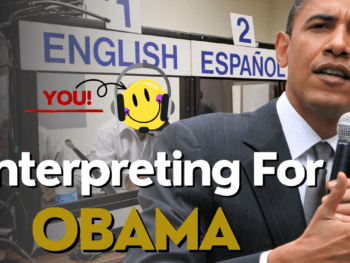






 How to Become a Translation Project Manager (Step By Step)
How to Become a Translation Project Manager (Step By Step)
Both are difficult and scarry
Both difficult
Absolutely, each mode has its own difficulties and particularities! Ideally, we should practice both on a regular basis. Thanks for the comment!
I think i’ll prefer to be a consecutive interpreter cz i think it will be hard in simultan situation that must listrn and speech in directly a same time.